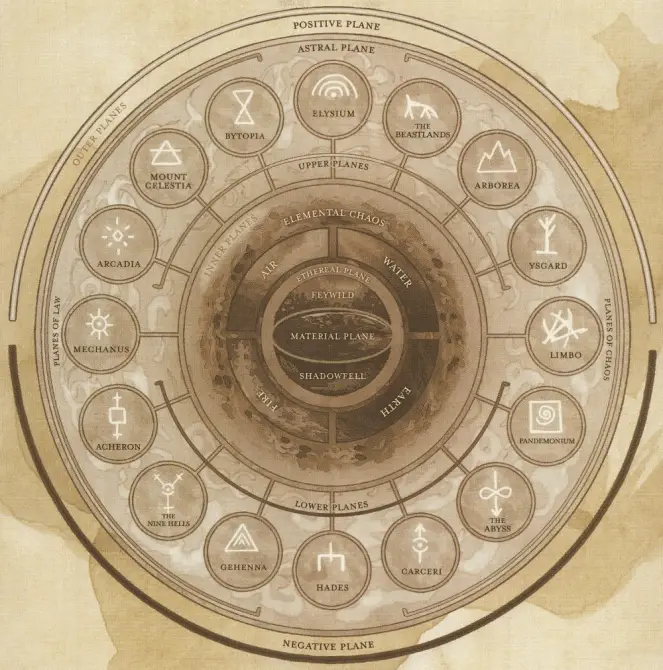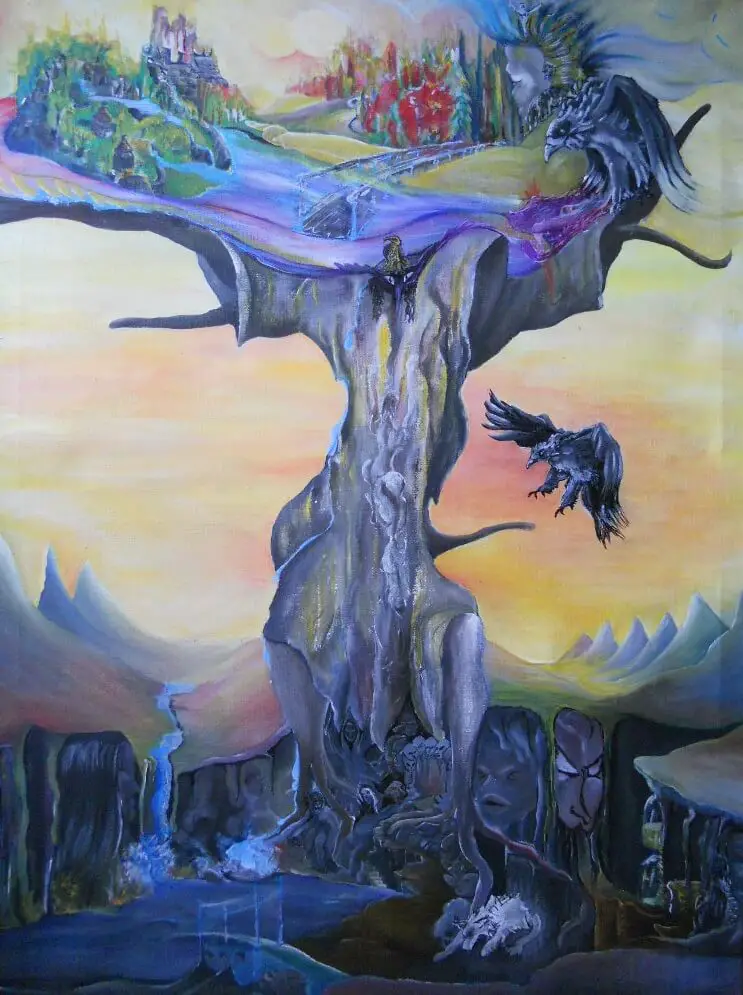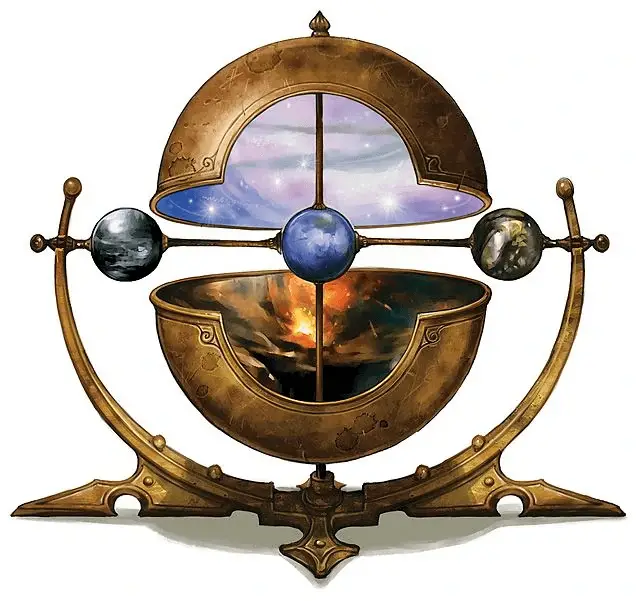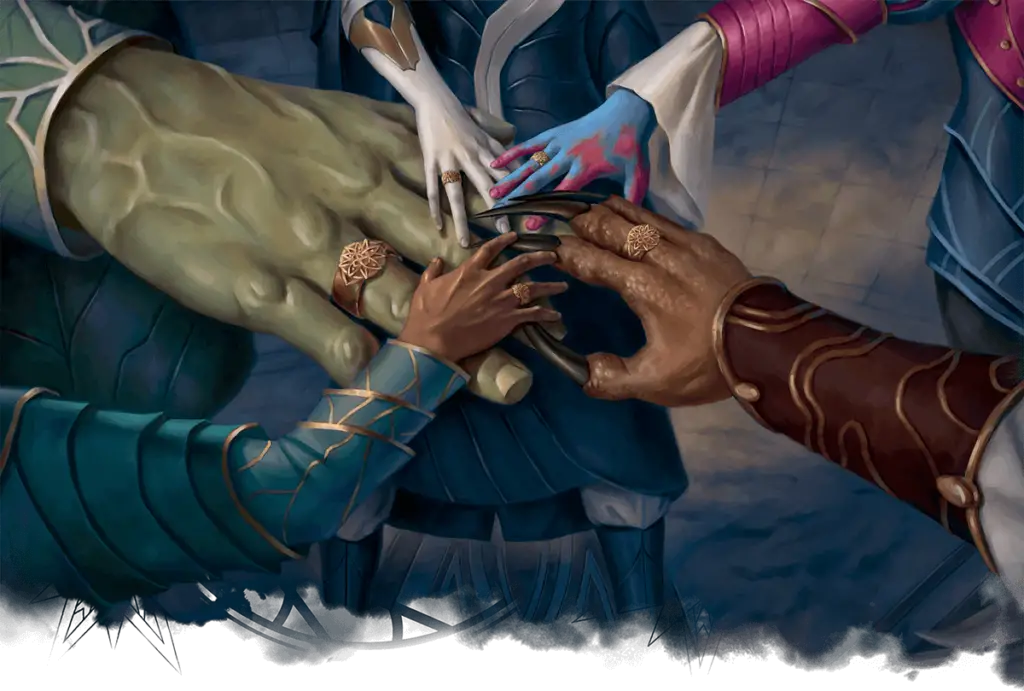D&D Cosmology featured image is credited to Wizards of the Coast’s D&D 5e Mythic Odysseys of Theros.
Disclaimer: This article contains affiliate links that add gold to our coffers.
The party braves fire and flames to descend into an active volcano to open the portal that will lead them to the legendary City of Brass. A hapless group of wanderers finds themselves lost in a mystical forest, and as they walk deeper into it, they slip accidentally into the realm of the fey. An archdeacon places fiery red gems on top of ornate silver bars at the feet of each of his companions’ beds. He sits at the center and begins an hour-long chant to send the whole group into the Astral Plane in search of a portal to Hades to hunt the Night Hag who stole their friend’s soul. These are the dangerous, compelling locations and plot hooks that lurk in D&D Cosmology!
The D&D multiverse has potential for diverse campaigns and adventures, but the complexity and scope of it can leave DMs intimidated and unsure how to use them. This series will dive into the lore and construction of the D&D planes and ways to use them with your table.
Visualizing D&D Cosmology
The sages of the Material Plane have constructed three models to make sense of the multiverse. However, these models do not necessarily represent the physical or even relational location of the planes. Many cosmological scholars theorize that there is no orientation, and it is not possible to have a top-down view of the layout of the cosmos. As such, any model is fundamentally flawed. Other philosophers argue that in some Material Planes, according to their creation, the cosmos do have a layout or orientation, and it is useful to have a theory of visualization to understand the Planes. These arguments exist because deities and planar beings have no interest in revealing the secrets of the planes to mere mortals. However, the DM is more powerful than the gods and can choose which model they prefer and how much the players know about it.
The first model is the Great Wheel, which aligns the planes around the Material plane like the spokes of a wheel. This is the default model presented for 5th Edition cosmology. The Great Wheel will serve most of your cosmological needs and is a decent template if creating your own multiverse.


The second theory of the cosmos is the World Tree. This can be conceptualized as the Material Plane as the center, the Upper Planes as the branches on the tree, and the Lower planes as the roots below, similar to Norse mythology.
Thirdly is the World Axis model. In this model, above the Material Plane is the Astral Plane that holds all of the Outer Planes. Below the Material Planes is the Elemental Chaos, which takes the place of the individual Elemental Planes. At the very bottom, like a hole in the fabric of the universe, sits the Abyss.

There are eight other models described on pg.44 of the DMG. Two that I want to highlight because they’re really cool are The Orrery and the One World models.
The Orrery is the cosmological model for the setting of Eberron. All of the Inner and Outer Planes are like moons that orbit around the Material Plane. As the planes pass over, they exert greater influence on the Material Plane. If you align the rotation of the planes according to time, this could give rise to a metaphysical reason for the seasons. On a long enough time span, it could create a cycle of prophecies that predict when certain planes will be above. For example, an ancient prophecy predicts the time when the Abyss shall pass over the Material Plane and cause it to be shrouded in death and destruction.
The One World model does away with the separation of planes, instead opting for only the Material Plane and physical locations on the plane that match what would be other planes. The Abyss is an actual location in the world, a deep dark place where demons spawn and crawl out of it to wreak havoc. Of course, one cannot simply walk into the Abyss. To visit these locations requires extraordinary effort. If the Abyss is at the bottom of a deep-sea trench, then characters would have to survive a dive into the darkest places of the world before they would find the Abyss. Similarly, Mount Celestia could be on the peak of an impossibly high mountain with steep cliffs and violent winds that make flying impossible.
The Planes of Traditional D&D Cosmology
D&D Planes are grouped into five distinct categories, depending on their relation to the Material Plane.
The Material Plane and Its Mirrors
At the center of D&D Cosmology is the Material Plane, the place where all of the planes and forces of the multiverse combine and collide to form a mortal world. How the mirror planes of the Fey Wild and Shadowfell arose are debated among sages, but they exist as a reflection of the Material Plane.
The Fey Wild is a realm of life and nature, home of the Fey. Its masters are the Archfey, ancient and powerful beings that can shape and control the fabric of the plane. Where a forest grows in the Material Plane, an untamed jungle with impossibly large trees that twist around each other may exist in the Fey Wild.
The Shadowfell is a place of death and gloom. There are no stars nor sun, and it’s home to the undead and other creatures of darkness. What could be considered as its masters are the mysterious Dark Powers who concern themselves with creating demiplanes called Domains of Dread, where Darklords become trapped in prisons of their own making. Where a mountain peak rises on the Material Plane, on Shadowfell, there may be a jagged rock outcropping shaped like a skull.
These two planes will be covered in more detail in Echoes of the Material World.
The Transitive Planes of D&D Cosmology
The Ethereal Plane and Astral Plane serve as boundaries between the different planes, acting like a border that one must cross through to travel to other planes.
The Ethereal Plane
Between the Material Plane and the Inner Planes is the foggy expanse of the Ethereal Plane. This plane serves as the border and transport corridor between these planes. It’s separated into two parts, a Border Ethereal where the Ethereal Plane meets one of the other planes, and a Deep Ethereal. Creatures can use the Deep Ethereal to travel between planes. The mechanics for this are described on p.48-49 of the DMG.
The Astral Plane
The Astral Plane functions as the transition plane between the Material Plane and the Outer Planes. It is a realm of thoughts and dreams. It is where the souls of creatures travel through to reach the Outer Planes and the afterlife.
Largely empty, the Astral Plane serves primarily as a way to reach the Outer Planes. To this end, travelers can seek out color pools that transport them to specific Outer Planes. Through the plane drift husks of dead gods, chunks of rocks, and other planar travelers. Psychic wind is an incredible danger to travelers in the Astral Plane. The specifics for psychic wind and color pools are on pg.47 of the DMG.
Planar travelers may encounter other creatures while searching for a color pool to another plane. These creatures may be wandering celestials or fiends, they may be fellow mortal travelers, or they may be the dreaded Githyanki. The Githyanki are astral raiders who serve at the behest of their lich-queen Vlaakith. They sail the astral sea in ships propelled by psychic magic, slaying planar travelers and raiding other planes. The Githyanki are formidable foes and a terror on the Astral Plane.
Their capital city, Tu’narath, rests on the calcified corpse of a six-armed god in the Astral Plane. Since Githyanki are raiders and hoarders, the loot collected in the city may be a draw for risky adventurers. Captives taken by the Githyanki often are slain when their captor loses interest in them, but the hardy or particularly lucky survivors make their way to the survivor communities in the District of Discards.
The city of Tu’narath can make for an adventure setting in its own right. The draw may be the stolen loot, either for the wealth it could bring or because a vital artifact was taken by the Githyanki. The draw could also be finding a captive who is important to the players. Alternatively, the players could be seeking to do business with the Githyanki, called there by Queen Vlaakith or one of her knights. Finally, the players may seek to find the rumored dungeon deep in the labyrinthian tunnels in the lower body of the dead god, a fortress ruled by a demigod who claimed the calcified god corpse before the Githyanki occupied it. More information on Tu’narath can be found in MToF on pages 91 and 92.
The Inner Planes, or the Elemental Planes
The four Elemental Planes are Water, Fire, Earth, Air. Some sages argue that the intersection of these four planes are planes in their own right: the planes of Ice, Ash, Magma, and Ooze. The Inner Planes can be conceptualized as forming a circle around the Material Plane. The closer the parts are to the Material Plane, the more they resemble it, and the further away from it, the more they resemble the pure element. At the farthest reaches, the Inner Planes bleed together to form the Elemental Chaos, pure unbridled elemental energy and substance clashing together.
Each of the Elemental Planes has civilized areas to them, places where humanoids from the Material Plane or genies, formed from an elemental spirit colliding with a soul, have created grand cities and citadels.
The Elemental Planes will be covered in more detail in Parts 3 and 4 of this series.
The Outer Planes, or the Spiritual Planes
The Outer Planes are realms of thought and soul. They are ruled by gods, devils, and demons. They are less of a place and are more of a state of being. The realm of Celestia, for instance, isn’t just a realm dedicated to the ideology of Lawful Good, it is a realm that is the manifestation of Lawful Good. Evil creatures wither in the plane, and even chaotic creatures may find it to be suffocating. The makeup of these planes is subject to the whims and desires of the forces that dwell on and control these planes, whether they be gods, demon lords, or archdevils.
The 16 Outer Planes will be covered in more detail in Parts 5 and 6 of this series. If you want to know how the Outer Planes relate to the afterlife, see my article on life after death in D&D.
The Positive and Negative Planes
D&D Cosmology can involve unforgiving, dangerous places. These two locations are rarely visited due to how dangerous they are and rarely discussed because of how featureless they are. The Positive Plane can be thought of as the pure essence of life, and the Negative Plane can be thought of as the pure essence of death. These two planes underpin and enfold the rest of the cosmology, giving rise to the forces that push and pull on the Material Plane, but the planes themselves are made of raw force. To visit the Negative Plane is to risk having your soul obliterated into the void, and to visit the Positive Plane is to risk your soul being shredded to its base parts and absorbed into the life-giving power of the Plane.
The Outlands
A plane that fits into none of the above categories but is neither part of the Far Realm or a Demiplane is the Outlands. It is a plane of pure neutrality, taking the shape of and connected to each of the 16 Outer Realms. At the gates to each of the planes is a town that takes on the likeness of the plane it is associated with, and they often serve as meeting points of planar emissaries. At the exact center of the plane is Sigil, the City of Doors. This is the domain of the Lady of Pain, a mysterious being as old as the gods with unknown motivations.
Sigil is a planar metropolis filled with goods from every corner of the multiverse. Within the city are countless planar portals that can lead travelers to many points within different planes, if they can find the right door and know how to operate it.
Since travel to the 16 Outer Planes in the Outlands does not necessarily require spells or operating portals, this could make an excellent place for a campaign centered around traveling to the Outer Planes. Your heroes could ride a horse from Mount Celestia to the Nine Hells without requiring any teleportation spells. The City of Doors also provides a place where they can find the supplies and magic items they might need for their adventure, though the price will depend on whom they’re bargaining with.
Planar Travel within D&D Cosmology
The traditional way of planar travel is through spells. There are three spells related to this: Astral Projection, Plane Shift, and Gate. However, there are ways other than spells to travel between planes. Banishment is a spell that could also be used to move through the planes.
Astral Projection
This 9th level spell allows players to enter the Astral Plane; however, it consumes 1,100 gp of material components per person transported. From here, they could search out a specific color pool to enter an Outer Plane, though this endeavor could take weeks of travel and is a dangerous task. However, it is a guaranteed way to travel to an Outer Plane that does not have the restrictions of other methods.
Plane Shift
The most important limitation on this spell is that you need a 250 gp tuning fork attuned to the location of choice. Besides being difficult to forge, and even harder to find, the proper resonating frequency of a plane is not common knowledge, and the research to find it out may be an adventure in its own right.
Gate
Gate is a 9th level spell that requires a 5,000 gp diamond to cast. The “precise location” wording of the spell may be interpreted as the players need to know a precise location for the spell to operate. Additionally, planar rulers can prevent any gate spells from opening in their domain if they so choose.
Planar Weak Points
Often associated with the Fey Wild, these are locations where the barrier between the planes is weak or nonexistent, allowing pieces or denizens of a plane to slip into the other one. These connect to Shadowfell or the Fey Wild, planes that have a strong connection to the Material Plane. These weak points might be deep within an untouched forest or a hole in a gloomy crypt in a sprawling graveyard. These can make convenient methods of transporting your players, whether they are aware of it or not.
Planar Portals
These are stationary connections to a specific location on another plane. It is the simplest way to travel to another plane, and the specifics of finding and using a planar portal can be an adventure in-and-of-itself. Planar Portals are thoroughly explained on pg.44 of the DMG.
Using D&D Cosmology In-Game
The planes of the D&D multiverse are dangerous places, but this does not mean only the highest level adventurers can explore them. Some are more dangerous than others, and locations within planes can vary in their danger. Certain areas of the Fey Wild, like a forest that’s home to a village of pixies and sprites, could be places where players find themselves while still low level.
An entire campaign could center around just a single plane. You’ll want to make sure you know your stuff regarding D&D Cosmology, but it’s very rewarding! Some ideas:
- The players are trapped in the Fey Wild and need to find a way out.
- The players are tasked with destroying one of the demon lords and must fight their cult on the Material Plane and, eventually, through the demon lord’s layer of the Abyss to wipe them out once-and-for-all.
- The players are abandoned captives in the Githyanki city of Tu’narath and either seek their revenge on the Githyanki knights who destroyed their village or are trying to survive the next purge of the survivors the lich-queen has ordered.
Alternatively, the planes could be the setting for part of an adventure. All of the planes can be grand and mystical, creating impossible configurations of space and time. Some ideas for being only part of a greater campaign:
- The players need to retrieve an artifact from a genie and have to infiltrate their palace on the Elemental Plane.
- The players need to form a peace treaty between two warring powers and choose to do so in the Hall of Concordance in Sigil under the strict enforcement of Kolyarut and his Maruts.
- The players need to retrieve an important soul or being who has been sealed away in the depths of Carceri by a vengeful deity.
- A celestial ally brings the players to their home plane for brief respite or to discuss a favor they want to ask of the players.
The lore to the D&D cosmology can add depth and excitement to your games and allow your players to visit grand locations or have strange encounters. The level of detail to the multiverse can be intimidating to a DM, but remember that knowledge of the planes is often uncertain. Even in a well-established cosmology, players do not need to know every detail, and the planes are places of metaphor, impossible and contradictory features, and unsolvable mystery. Consider adding more of the planes to your setting and letting your players enter the mystical and fantastical layers of the multiverse.





Great idea for a series! I love reading about the planes and its fantastical places such as the City of Brass or Sigil to jump start my imagination 🙂
We’re glad you like it! More coming soon. 🙂